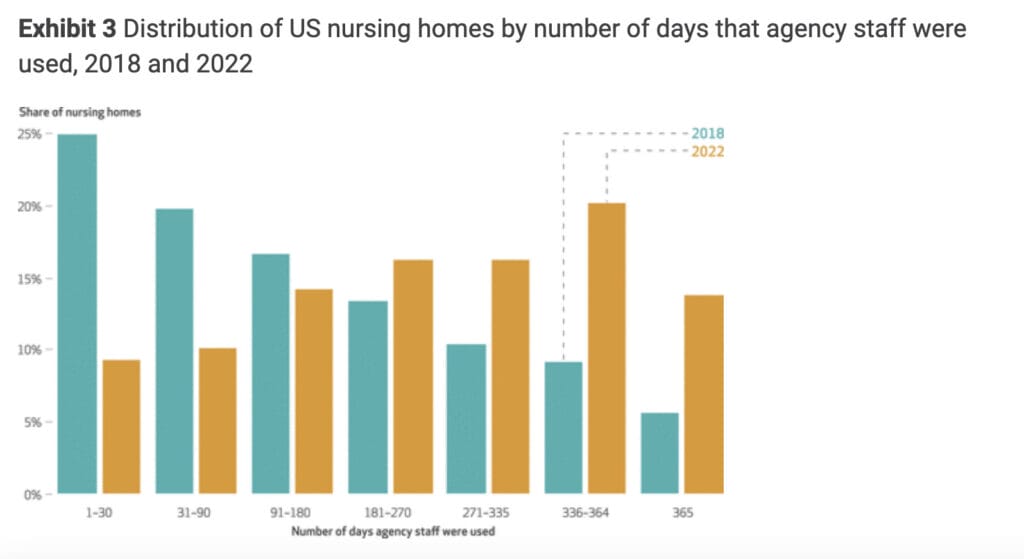
The share of nursing homes using agency staff every day of the year more than doubled between 2018 and 2022, newly published research shows — further fueling concerns about the prospect of a federal staffing mandate being finalized soon.
Nursing homes have become significantly more reliant on staffing agency workers since before the COVID-19 pandemic, leaving them threatened by compounded wage costs and worker shortages, research published online in Health Affairs late Wednesday confirms. Although the level of dependence has waned from its most severe, it is still a significant factor, experts agree.
The percentage of nursing homes that use agency care workers more than doubled from 2018 to 2022 — from less than 20% to nearly 50%. All told, agency staff went from accounting for 3% of all direct care hours in 2018 to 11% in 2022.
Critically, the role those staff filled in nursing homes changed as well, according to lead author John Bowblis, PhD, professor and research fellow at the Scripps Gerontology Center of Miami University.
In 2018, agency staff were primarily used to fill short-term gaps in staffing or spikes in occupancy. By 2022, a large portion of the long-term care sector had come to rely on agency work just to meet everyday needs.
“We found that the most common use of agency staff prior to the pandemic was for a few days each year,” Bowblis told McKnight’s Long-Term Care News Thursday. “By 2022, almost 35% of nursing homes were using agency staff every day. This is a clear sign there is a shortage in the availability of workers.”

Agency staffing only increased in cost as the dangers and labor trends of the pandemic drove everyday care workers’ wages higher and decreased the available number of those everyday workers as many transitioned into agencies, seeking greater shift flexibility.
“The pandemic changed how Americans work,” Bowblis said. “Americans want to work from home or have more flexibility in the hours they do work. … Staffing agencies allow workers to have this flexibility to not accept shifts they do not want to work, but it is not a good long-term solution.”
These labor trends are converging to put significant financial pressure on nursing homes, confirmed the study.
“Nursing homes were hit twice,” Bowblis explained. “First, they needed to pay existing workers more. Second, if a nursing home had to rely on agency staff to fill a shift, they had to pay an extra 50% to 66% more than it would cost to have a directly employed staff member work the shift.”
Worker demands and workforce challenges
With a proposed federal nursing home staffing mandate on the horizon, operating with the additional costs of agency workers has become an even stronger possibility and threat.
More than half of skilled nursing leaders surveyed by McKnight’s at the end of 2023 said they would need to hire more agency workers if such a mandate is finalized.
The study’s authors noted that most of nursing homes’ revenue comes from set Medicare and Medicaid rates. With COVID relief funds dried up and many state governments slow to increase reimbursement rates, or bring them on in a lagging fashion, facilities may find themselves caught even worse between the rock of lacking the funding to hire even more staff and the hard place of being federally required to do so.
“Our study points to a clear problem that CMS has not addressed: Where are we going to find nursing home workers?” Bowblis observed. “Pushing forward with a staffing mandate without assuring that nursing homes can afford to increase staffing and, most importantly, find workers to fill the necessary positions is vital if CMS’ wants to have any success in trying to implement a minimum staffing requirement.”





